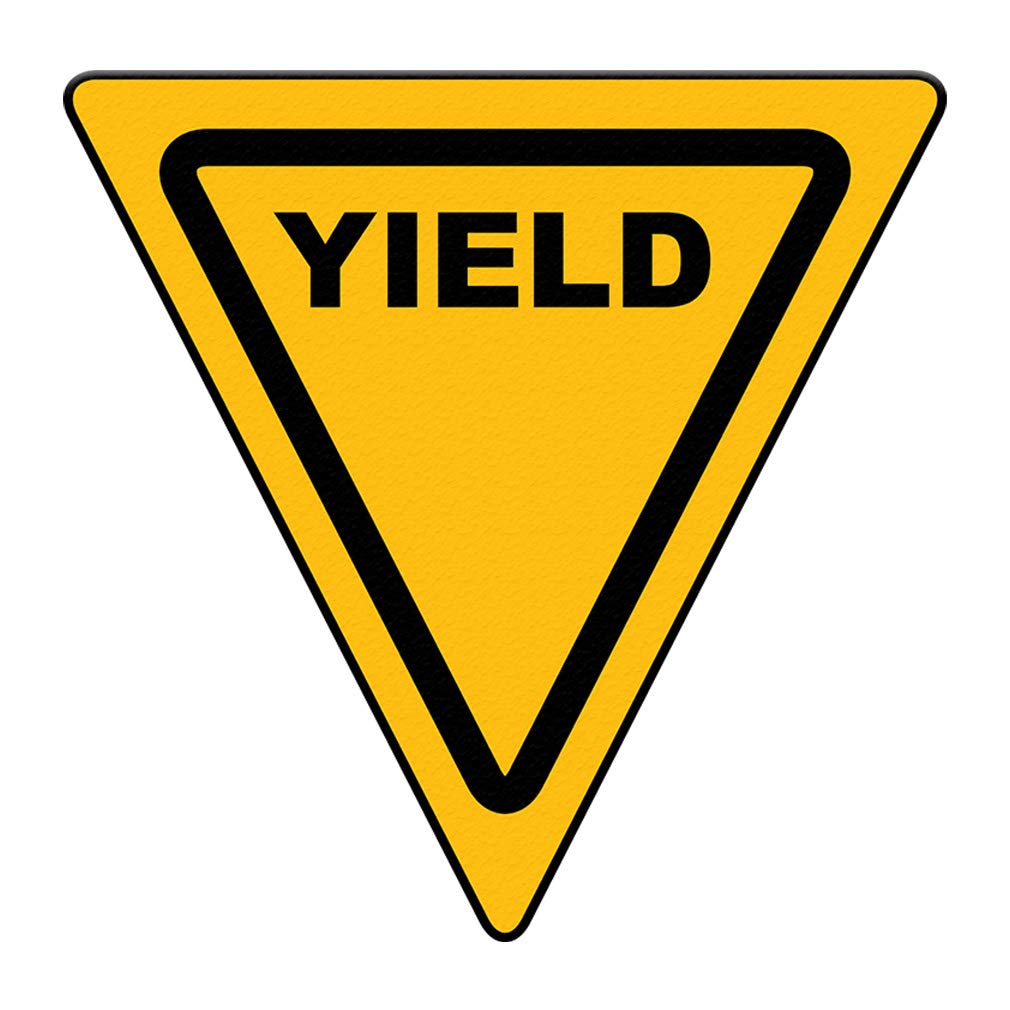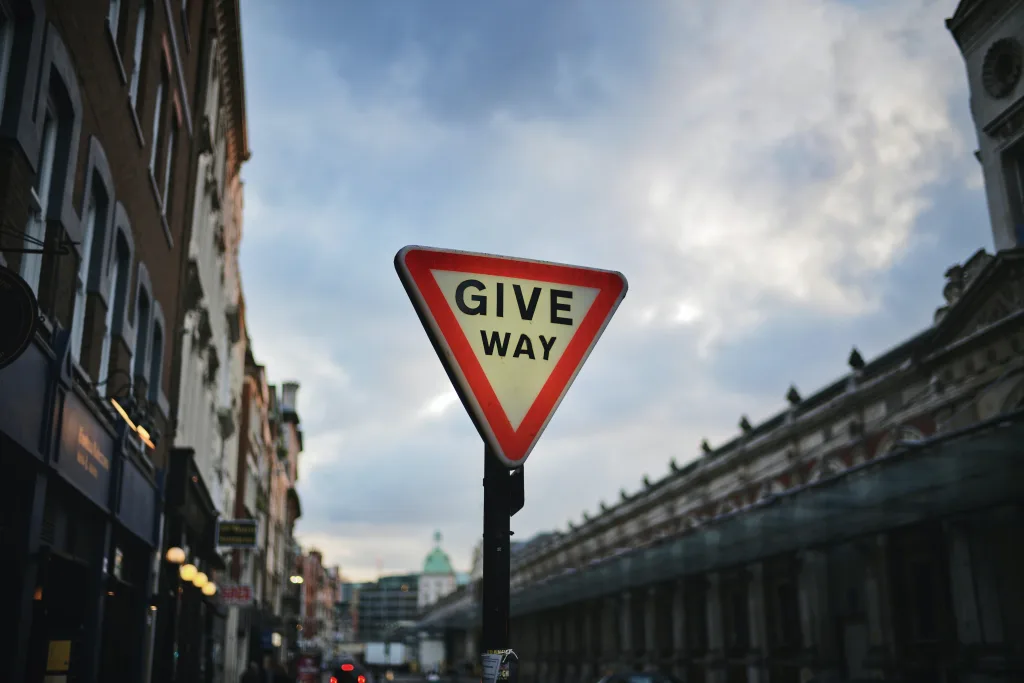The yellow yield sign, often mistaken as the standard color for this regulatory sign, has garnered attention and sparked curiosity among many. However, it is important to note that the actual color of a yield sign, at least in the United States, is red and white. This fact may come as a surprise to those who have long believed that yield signs are yellow. In reality, the color yellow is universally recognized as a cautionary color.
The concept of a yield sign was first introduced in 1952 and later added to the Manual on Uniform Traffic Control Devices (MUTCD) in 1954. Initially, the sign featured a keystone shape, which was later replaced by the more familiar triangular shape. At this time, yield signs were indeed yellow in color, just like caution signs. However, in 1971, the sign underwent a significant change. It adopted a new design, similar to the modern version we see today, and switched from yellow to red.
The change from yellow to red for yield signs mirrored a similar change that had previously been made to stop signs. Red is universally understood as the color for stop, making it a logical choice for both stop signs and yield signs. The red and white color combination used on yield signs helps to distinguish them from other types of signs and ensures that they are easily recognizable by drivers.
It is worth mentioning that while red and white are the standard colors for yield signs in most countries, there are some regions that incorporate yellow or blue into their design. These variations often follow local traffic regulations and conventions.
The purpose of a yield sign is to alert drivers to the need to slow down and yield the right-of-way to pedestrians and vehicles approaching from other directions. This is a critical rule of the road that helps to prevent accidents and ensure the safety of all road users.
Despite the common misconception that yield signs are yellow, they are actually red and white in the United States and many other countries. The use of red helps to reinforce the message of stopping or yielding, which is consistent with the color used on stop signs. Understanding the proper color of a yield sign is essential for all drivers to ensure they respond appropriately to this important traffic control device.
What Does A Yellow Yield Sign Mean?
A yellow yield sign is a type of regulatory sign that carries a specific meaning on the road. When encountering a yellow yield sign while driving, it indicates that you must slow down and be prepared to yield the right-of-way to pedestrians and vehicles approaching from another direction. The purpose of a yield sign is to ensure safety and prevent accidents by allowing other road users to proceed first.
Key points about the meaning of a yellow yield sign:
1. Slowing down: The yellow color of the yield sign serves as a visual cue for drivers to reduce their speed. This allows for better control and reaction time when yielding to other vehicles or pedestrians.
2. Right-of-way: Yielding the right-of-way means giving priority or allowing others to go first. When approaching a yield sign, you must yield to any oncoming traffic or pedestrians who have the right-of-way.
3. Check for approaching traffic: Before proceeding through a yield sign, it is essential to carefully check for any vehicles or pedestrians that may be approaching from another direction. This ensures safe and efficient traffic flow.
4. Flexibility in traffic situations: Yield signs are typically used at intersections or merging points where the traffic flow may require some adjustment. By yielding, drivers can adapt to changing traffic patterns and prevent congestion or accidents.
A yellow yield sign signifies the need to slow down and yield the right-of-way to other vehicles and pedestrians. It is crucial to approach yield signs with caution, check for approaching traffic, and proceed only when it is safe to do so. Following these guidelines helps ensure safe and efficient traffic flow on the road.

Are There Any Yellow Yield Signs?
There are yield signs that are yellow in color. While the standard yield signs in the US and most countries are red and white, some places do use yellow yield signs. It is important to note that the majority of yield signs are red and white, but there are exceptions. Here are some examples of situations where yellow yield signs may be used:
1. Temporary or construction zones: In areas where there is road work or construction happening, temporary yellow yield signs may be used to indicate that drivers should yield to oncoming traffic or pedestrians.
2. Specific road conditions: In certain locations where road conditions are hazardous, such as sharp curves or steep inclines, yellow yield signs may be used to alert drivers to exercise caution and yield if necessary.
3. Local regulations: Some local jurisdictions may have specific rules or regulations that require the use of yellow yield signs in certain situations.
It is important to adhere to the specific traffic regulations and signage in your area, as they may vary. Always pay attention to the color and shape of yield signs, as they provide important instructions for safe driving.
What Is The Difference Between A Yellow Yield Sign And A Red Yield Sign?
The main difference between a yellow yield sign and a red yield sign lies in their color and the messages they convey. Here are the key distinctions:
Yellow Yield Sign:
– Color: The yellow yield sign has a bright yellow background with black lettering.
– Cautionary Signal: The yellow color serves as a universal symbol for caution, indicating that drivers should proceed with care.
– Warning: This sign is typically used to warn drivers of upcoming hazards, such as sharp turns, intersections, or road work zones.
– Slow Down: It prompts drivers to slow down and be prepared to yield to oncoming traffic or pedestrians.
– Awareness: The yellow yield sign grabs attention and alerts drivers to potential dangers ahead.
Red Yield Sign:
– Color: The red yield sign features a red background with white lettering.
– Stop Signal: The red color is universally recognized as a stop signal, indicating that drivers must come to a complete stop.
– Immediate Action: When encountering a red yield sign, drivers must yield the right of way to other vehicles or pedestrians before proceeding.
– Intersection Control: Red yield signs are often used at intersections where traffic flow needs to be regulated, ensuring safe and orderly movement.
– Priority: It emphasizes the importance of yielding and emphasizes that drivers must give way to others before continuing.
While both yellow and red yield signs convey the message of yielding, the yellow sign primarily serves as a cautionary warning, while the red sign demands immediate action and requires drivers to come to a complete stop.
When Was The Yield Sign Yellow?
The yield sign was initially introduced in 1952 and was added to the Manual on Uniform Traffic Control Devices (MUTCD) in 1954. During this period, the yield sign used a “keystone” shape before later transitioning to the more commonly recognized triangular shape. At its inception, the yield sign was colored yellow, similar to the initial color of stop signs.
However, in 1971, the yield sign underwent a transformation and adopted its modern version. Along with this change, the color of the yield sign was also altered, following the same shift that had previously occurred with stop signs. The yellow color of the yield sign was replaced with a vibrant red hue, which is still in use today.
Please note that the information provided is based on historical records and may vary depending on local regulations or specific circumstances.

Conclusion
While there may be some confusion about the color of yield signs, it is important to note that the standard yield sign in the US and most countries is red and white. The misconception that yield signs are yellow may stem from the fact that yellow is commonly associated with caution. However, the use of red on yield signs is intentional, as red is universally recognized as a color for stop and commands attention.
The history of the yield sign reveals that it has evolved over time to its current triangular shape and red color. Originally introduced in 1952, the sign used a keystone shape before transitioning to the more recognizable triangular shape in 1971. This change also coincided with the shift from yellow to red, following the same pattern as stop signs.
Understanding the color and shape of yield signs is crucial for drivers to know when to slow down and yield the right-of-way to pedestrians and vehicles approaching from other directions. By adhering to the red and white yield signs, drivers can ensure safer roads and reduce the risk of accidents.
It is important to remember that yield signs are red and white, not yellow. This knowledge will help drivers make informed decisions on the road and contribute to a more efficient and safe traffic flow.
